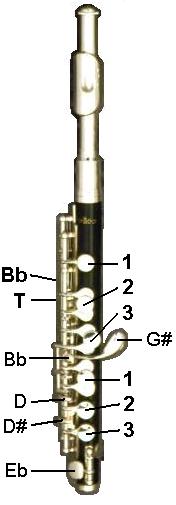All
Keys Pressed and All Holes CoveredConcert
Flute
Bb
B 123G#|Bb1D2D#3Eb C# C B ß              
Piccolo
Bb
B 123G#|Bb1D2D#3Eb X              
Left
Thumb KeysB
   · B-natural lever
· B-natural lever Bb
   · Bb lever ("Thumb Bb")
· Bb lever ("Thumb Bb")
The B thumb lever is the primary thumb
key and is located closer to the instrument's foot than the Bb thumb lever. Either
lever can be used for fingerings in which the LH middle finger key and/or the
RH index finger key are depressed, in which case the thumb is indicated by T
and    . .
Left
Hand Main Keys1
   · Index finger key (C)
· Index finger key (C) 2
   · Middle finger key (A)
· Middle finger key (A) 3
   · Ring finger key (G)
· Ring finger key (G)
Left
Hand Little Finger (Pinky) KeysG#
   · G# key
· G# key
The G# key is the only left hand little finger key and is used
primarily to play G#.
Right
Hand Main Keys1
   · Index finger key (F)
· Index finger key (F) 2
   · Middle finger key (E)
· Middle finger key (E) 3
   · Ring finger key (D)
· Ring finger key (D)
Right
Hand Trill KeysBb
   · Bb trill key
· Bb trill key
The Bb trill key is located above the first finger key
of the right hand and is used to trill A#-B in the first and second octaves as
well as to give an alternative fingering to Bb. C#
   · C# trill key
· C# trill key
The C# trill key is located next to the Bb trill key on some flute
models. They key is used for certain trills involving C#5,
C#6, and G6-A6. (The white key
shown in this key image is the Bb trill key.)
D
   · D trill key
· D trill key
The D trill key is located between the first and second
finger keys of the right hand and is used for trills involving second-octave D
and third-octave Eb and for playing third-octave Bb. D#
   · D# trill key
· D# trill key
The D# trill key is located between the second and third
finger keys of the right hand and is used for trills involving second-octave Eb
and third-octave D and Eb and for playing third-octave B.
Right
Hand Little Finger (Pinky) KeysEb
   · Eb key
· Eb key
The Eb key is used for playing Eb in any octave. It also serves
as a vent in the majority of flute fingerings, and its use helps balance the flute.
C#
   · Low C# key
· Low C# key
The low C# key is the outer right hand little finger key
and is used primarily for playing low C#. C
   · Low C key
· Low C key
The low C key is middle right hand little finger key and is
used primarily for playing low C. B
   · Low B key
· Low B key
The low B key is inner right hand little finger key and is
used primarily for playing low B. ß
   · High C Facilitator Key (Gizmo Key)
· High C Facilitator Key (Gizmo Key)
The gizmo key improves the
tone and response of fourth-octave C and a few surrounding notes and trills. The
key is located on top of the low B and low C keys.
Main
Keys and Venting 1
   : Depress index finger key ring and cover tone hole.
: Depress index finger key ring and cover tone hole. 2
   : Depress middle finger key ring and cover tone hole.
: Depress middle finger key ring and cover tone hole. 3
   : Depress ring finger key ring and cover tone hole.
: Depress ring finger key ring and cover tone hole. -
   : Leave tone hole open and key ring not depressed.
: Leave tone hole open and key ring not depressed. 0
   : Depress key ring but leave tone hole uncovered.
: Depress key ring but leave tone hole uncovered. ¼
   or
or    : Depress key ring but cover only a small part of the tone hole.
: Depress key ring but cover only a small part of the tone hole. ½
   or
or    : Depress key ring but cover only half of the tone hole.
: Depress key ring but cover only half of the tone hole. ¾
   or
or    : Depress key ring and cover most but not all the tone hole.
: Depress key ring and cover most but not all the tone hole.
Other
Symbols|
   separates left hand keys from right hand keys.
separates left hand keys from right hand keys. X
   indicates that the foot end of the instrument should be closed. For piccolo, use
the right hand little finger.
indicates that the foot end of the instrument should be closed. For piccolo, use
the right hand little finger.
Trilled
Keys
Keys to be trilled are indicated in red boldface text
and by red key images (e.g.,    ). ).
For a fingering involving more than one trilled key, the trilled keys are to be
trilled simultaneously unless specified as alternating in the fingering description.
Alternating trill keys are also indicated by a combination of red
boldface text and red boldface italic text.
| 


